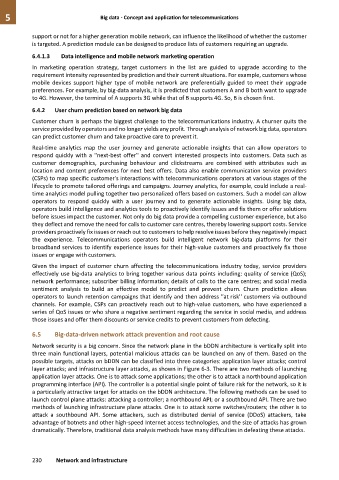Page 238 - Big data - Concept and application for telecommunications
P. 238
5 Big data - Concept and application for telecommunications
support or not for a higher generation mobile network, can influence the likelihood of whether the customer
is targeted. A prediction module can be designed to produce lists of customers requiring an upgrade.
6.4.1.3 Data intelligence and mobile network marketing operation
In marketing operation strategy, target customers in the list are guided to upgrade according to the
requirement intensity represented by prediction and their current situations. For example, customers whose
mobile devices support higher type of mobile network are preferentially guided to meet their upgrade
preferences. For example, by big-data analysis, it is predicted that customers A and B both want to upgrade
to 4G. However, the terminal of A supports 3G while that of B supports 4G. So, B is chosen first.
6.4.2 User churn prediction based on network big data
Customer churn is perhaps the biggest challenge to the telecommunications industry. A churner quits the
service provided by operators and no longer yields any profit. Through analysis of network big data, operators
can predict customer churn and take proactive care to prevent it.
Real-time analytics map the user journey and generate actionable insights that can allow operators to
respond quickly with a ''next-best offer'' and convert interested prospects into customers. Data such as
customer demographics, purchasing behaviour and clickstreams are combined with attributes such as
location and content preferences for next best offers. Data also enable communication service providers
(CSPs) to map specific customer's interactions with telecommunications operators at various stages of the
lifecycle to promote tailored offerings and campaigns. Journey analytics, for example, could include a real-
time analytics model pulling together two personalized offers based on customers. Such a model can allow
operators to respond quickly with a user journey and to generate actionable insights. Using big data,
operators build intelligence and analytics tools to proactively identify issues and fix them or offer solutions
before issues impact the customer. Not only do big data provide a compelling customer experience, but also
they deflect and remove the need for calls to customer care centres, thereby lowering support costs. Service
providers proactively fix issues or reach out to customers to help resolve issues before they negatively impact
the experience. Telecommunications operators build intelligent network big-data platforms for their
broadband services to identify experience issues for their high-value customers and proactively fix those
issues or engage with customers.
Given the impact of customer churn affecting the telecommunications industry today, service providers
effectively use big-data analytics to bring together various data points including: quality of service (QoS);
network performance; subscriber billing information; details of calls to the care centres; and social media
sentiment analysis to build an effective model to predict and prevent churn. Churn prediction allows
operators to launch retention campaigns that identify and then address ''at risk'' customers via outbound
channels. For example, CSPs can proactively reach out to high-value customers, who have experienced a
series of QoS issues or who share a negative sentiment regarding the service in social media, and address
those issues and offer them discounts or service credits to prevent customers from defecting.
6.5 Big-data-driven network attack prevention and root cause
Network security is a big concern. Since the network plane in the bDDN architecture is vertically split into
three main functional layers, potential malicious attacks can be launched on any of them. Based on the
possible targets, attacks on bDDN can be classified into three categories: application layer attacks; control
layer attacks; and infrastructure layer attacks, as shown in Figure 6-3. There are two methods of launching
application layer attacks. One is to attack some applications; the other is to attack a northbound application
programming interface (API). The controller is a potential single point of failure risk for the network, so it is
a particularly attractive target for attacks on the bDDN architecture. The following methods can be used to
launch control plane attacks: attacking a controller; a northbound API; or a southbound API. There are two
methods of launching infrastructure plane attacks. One is to attack some switches/routers; the other is to
attack a southbound API. Some attackers, such as distributed denial of service (DDoS) attackers, take
advantage of botnets and other high-speed Internet access technologies, and the size of attacks has grown
dramatically. Therefore, traditional data analysis methods have many difficulties in defeating these attacks.
230 Network and infrastructure

